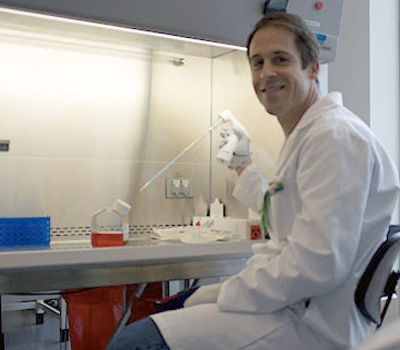Using high throughput screening and state-of-the-art biotechnology to identify drug targets for muscular dystrophy
A slowly progressive condition, FSHD is a debilitating late childhood-onset disease with initial symptoms occurring primarily in the muscles of the face, upper arm, and scapula; frequently the symptoms progress to the point of confining people to wheelchairs or even forcing them to become bedridden. Dr. Daniel Miller, Associate Professor of the University of Washington's Department of Pediatrics is researching the causes and effects of this disease in the hopes of restoring a normal quality of life to those suffering from it. Dr. Miller is taking a two pronged approach, studying first why the rogue DUX4 gene that causes FSHD is being expressed, and secondly what intervention methods may be possible to prevent DUX4 expression and help ailing patients. This disease is often diagnosed in a patient's early-to-mid teenage years during a developmental stage when most teenagers feel invincible. The news of a diagnosis can be devastating. With his research Dr. Miller is offering to return to patients the control of their own bodies. He is working to restore a healthy lifestyle to individuals who should never hear that they may be confined to a wheelchair for the remainder of their lives. Understanding the basics of how and why this disease attacks muscles the way that it does will lead to effective treatments that will stop disease progression, and potentially reverse its effects.
Facioscapulohumeral muscular dystrophy (FSHD) is one of, if not the most prevalent variation of muscular dystrophy diseases, though its slowly progressive nature has allowed it to thrive under the medical news radar. It is a unique variation because it is caused by the inappropriate expression of the DUX4 gene resulting from incorrect packaging of the DNA in the nucleus. The expression of this gene causes inappropriate activation of other genes, making the muscle cell function abnormally and eventually die. Due to the fact that FSHD is a slowly progressive condition, it may be possible to inhibit the progression early on and prevent susceptible individuals from ever experiencing the disease symptoms.
Dr. Miller's current research is concentrated on Facioscapulohumeral muscular dystrophy (FSHD). He is studying this disease in two parts: why it is present, and how it works to kill healthy muscle cells.
-
Facioscapulohumeral muscular dystrophy (FSHD) is caused by the rogue expression of the DUX4 gene. In individuals suffering from this disease, the DUX4 gene is being expressed when it shouldn't be due to errors in the way the DUX4 gene is packaged in the cell. The incorrect packaging causes DUX4 to become inappropriately expressed and allows DUX4 to activate the codes for other non-muscle cell types, killing healthy muscle cells in the process. Cell instructions encoded by specific groups of genes work like computer software programs; the appropriate instructions are the only part of the DNA that can be read and the instructions are only appropriate for a single type of cell (in this case muscle). The rest of the information (information to become a skin cell for example) is hidden by packaging it tightly within the muscle cell. This packaging process occurs during development and if an error occurs, the error-prone packaging state is propagated to the progeny of that particular cell. Dr. Miller is working at the molecular level to understand why the DUX4 gene is accessible in muscle cells when it shouldn't be. Improper information packaging is one of the fundamental mechanisms allowing cancer cells to divide uncontrollably so Dr. Miller believes that the efforts of pharmaceutical companies to control cancer may someday be applicable to FSHD.
-
Another way to fight inappropriate DUX4 expression is to figure out what happens "downstream" once the DUX4 information has been read. Dr. Miller accomplishes this by studying how the muscle cells are being killed. Using a number of high throughput robotics-based screens, Dr. Miller and his team are examining the effect of many different candidate genes on DUX4-induced cell death, including genes involved in the DUX4 silencing pathway and chemicals with similar silencing effects. By figuring out the mechanisms by which the gene is killing muscle cells and identifying the proteins involved, Dr. Miller hopes to identify and target specific cellular pathways to treat FSHD.
Bio
From an educational perspective, Dr. Daniel Miller took an interesting approach to becoming an Associate Professor and medical doctor. Dr. Miller had always thought he would become a physician, but after receiving a bachelor's degree in Biology from Whitman, a liberal arts college in central Washington, a summer internship working in a medical research lab directed his interests towards medical research. Dr. Miller then applied to a combined degree program at the University of Washington where he received his Ph.D. and M.D. in Medicine/Pathology. After further specialization in Pediatric Genetics, Dr. Miller encountered a patient with Facioscapulohumeral Muscular Dystrophy and became both intrigued by the biology and struck by the opportunity to help people with this condition.
Dr. Miller is a self-proclaimed closet engineer; fascinated by real-world engineering problems. His hobbies include restoring old wood-working machinery, building tools on his metal lathe and mill, and programming computer software. Dr. Miller has discovered how to translate his hands-on passions to the cellular and molecular level by working with structural problems associated with Facioscapulohumeral muscular dystrophy (FSHD). Dr. Miller decided to study FSHD in his lab after witnessing an ailing patient in the medical genetics clinic at Children's hospital. He was both moved by the progression of her muscle weakness, and perplexed by the models that were presented to explain the disease mechanism. Making connections with several people affected by this disease and their families has made this research personal, increasing the urgency, importance, and satisfaction of his discoveries.


